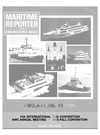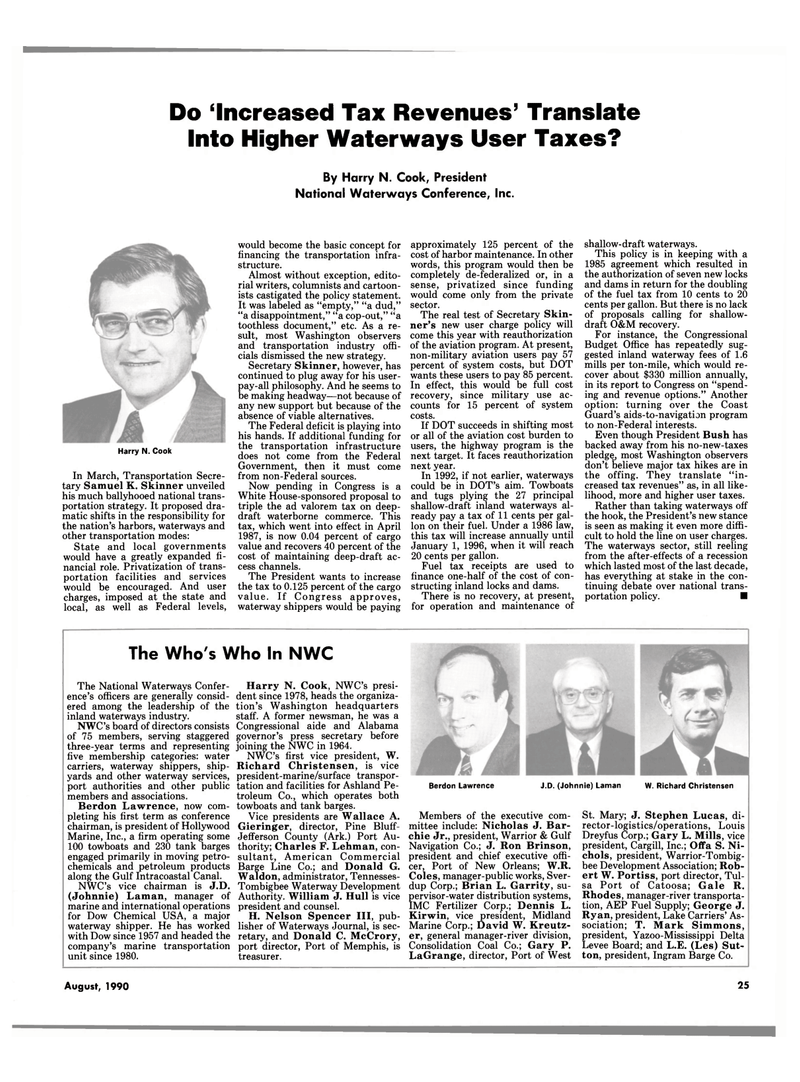
Page 25: of Maritime Reporter Magazine (August 1990)
Read this page in Pdf, Flash or Html5 edition of August 1990 Maritime Reporter Magazine
Do increased Tax Revenues' Translate
Into Higher Waterways User Taxes?
By Harry N. Cook, President
National Waterways Conference, Inc.
Harry N. Cook
In March, Transportation Secre- tary Samuel K. Skinner unveiled his much ballyhooed national trans- portation strategy. It proposed dra- matic shifts in the responsibility for the nation's harbors, waterways and other transportation modes:
State and local governments would have a greatly expanded fi- nancial role. Privatization of trans- portation facilities and services would be encouraged. And user charges, imposed at the state and local, as well as Federal levels, would become the basic concept for financing the transportation infra- structure.
Almost without exception, edito- rial writers, columnists and cartoon- ists castigated the policy statement.
It was labeled as "empty," "a dud," "a disappointment," "a cop-out," "a toothless document," etc. As a re- sult, most Washington observers and transportation industry offi- cials dismissed the new strategy.
Secretary Skinner, however, has continued to plug away for his user- pay-all philosophy. And he seems to be making headway—not because of any new support but because of the absence of viable alternatives.
The Federal deficit is playing into his hands. If additional funding for the transportation infrastructure does not come from the Federal
Government, then it must come from non-Federal sources.
Now pending in Congress is a
White House-sponsored proposal to triple the ad valorem tax on deep- draft waterborne commerce. This tax, which went into effect in April 1987, is now 0.04 percent of cargo value and recovers 40 percent of the cost of maintaining deep-draft ac- cess channels.
The President wants to increase the tax to 0.125 percent of the cargo value. If Congress approves, waterway shippers would be paying approximately 125 percent of the cost of harbor maintenance. In other words, this program would then be completely de-federalized or, in a sense, privatized since funding would come only from the private sector.
The real test of Secretary Skin- ner's new user charge policy will come this year with reauthorization of the aviation program. At present, non-military aviation users pay 57 percent of system costs, but DOT wants these users to pay 85 percent.
In effect, this would be full cost recovery, since military use ac- counts for 15 percent of system costs.
If DOT succeeds in shifting most or all of the aviation cost burden to users, the highway program is the next target. It faces reauthorization next year.
In 1992, if not earlier, waterways could be in DOT's aim. Towboats and tugs plying the 27 principal shallow-draft inland waterways al- ready pay a tax of 11 cents per gal- lon on their fuel. Under a 1986 law, this tax will increase annually until
January 1, 1996, when it will reach 20 cents per gallon.
Fuel tax receipts are used to finance one-half of the cost of con- structing inland locks and dams.
There is no recovery, at present, for operation and maintenance of shallow-draft waterways.
This policy is in keeping with a 1985 agreement which resulted in the authorization of seven new locks and dams in return for the doubling of the fuel tax from 10 cents to 20 cents per gallon. But there is no lack of proposals calling for shallow- draft O&M recovery.
For instance, the Congressional
Budget Office has repeatedly sug- gested inland waterway fees of 1.6 mills per ton-mile, which would re- cover about $330 million annually, in its report to Congress on "spend- ing and revenue options." Another option: turning over the Coast
Guard's aids-to-navigation program to non-Federal interests.
Even though President Bush has backed away from his no-new-taxes pledge, most Washington observers don't believe major tax hikes are in the offing. They translate "in- creased tax revenues" as, in all like- lihood, more and higher user taxes.
Rather than taking waterways off the hook, the President's new stance is seen as making it even more diffi- cult to hold the line on user charges.
The waterways sector, still reeling from the after-effects of a recession which lasted most of the last decade, has everything at stake in the con- tinuing debate over national trans- portation policy. •
The National Waterways Confer- ence's officers are generally consid- ered among the leadership of the inland waterways industry.
NWC's board of directors consists of 75 members, serving staggered three-year terms and representing five membership categories: water carriers, waterway shippers, ship- yards and other waterway services, port authorities and other public members and associations.
Berdon Lawrence, now com- pleting his first term as conference chairman, is president of Hollywood
Marine, Inc., a firm operating some 100 towboats and 230 tank barges engaged primarily in moving petro- chemicals and petroleum products along the Gulf Intracoastal Canal.
NWC's vice chairman is J.D. (Johnnie) Laman, manager of marine and international operations for Dow Chemical USA, a major waterway shipper. He has worked with Dow since 1957 and headed the company's marine transportation unit since 1980.
Harry N. Cook, NWC's presi- dent since 1978, heads the organiza- tion's Washington headquarters staff. A former newsman, he was a
Congressional aide and Alabama governor's press secretary before joining the NWC in 1964.
NWC's first vice president, W.
Richard Christensen, is vice president-marine/surface transpor- tation and facilities for Ashland Pe- troleum Co., which operates both towboats and tank barges.
Vice presidents are Wallace A.
Gieringer, director, Pine Bluff-
Jefferson County (Ark.) Port Au- thority; Charles F. Lehman, con- sultant, American Commercial
Barge Line Co.; and Donald G.
Waldon, administrator, Tennesses-
Tombigbee Waterway Development
Authority. William J. Hull is vice president and counsel.
H. Nelson Spencer III, pub- lisher of Waterways Journal, is sec- retary, and Donald C. McCrory, port director, Port of Memphis, is treasurer.
Berdon Lawrence J.D. (Johnnie) Laman W. Richard Christensen
Members of the executive com- mittee include: Nicholas J. Bar- chie Jr., president, Warrior & Gulf
Navigation Co.; J. Ron Brinson, president and chief executive offi- cer, Port of New Orleans; W.R.
Coles, manager-public works, Sver- dup Corp.; Brian L. Garrity, su- pervisor-water distribution systems,
IMC Fertilizer Corp.; Dennis L.
Kirwin, vice president, Midland
Marine Corp.; David W. Kreutz- er, general manager-river division,
Consolidation Coal Co.; Gary P.
LaGrange, director, Port of West
St. Mary; J. Stephen Lucas, di- rector-logistics/operations, Louis
Dreyfus Corp.; Gary L. Mills, vice president, Cargill, Inc.; OfFa S. Ni- chols, president, Warrior-Tombig- bee Development Association; Rob- ert W. Portiss, port director, Tul- sa Port of Catoosa; Gale R.
Rhodes, manager-river transporta- tion, AEP Fuel Supply; George J.
Ryan, president, Lake Carriers' As- sociation; T. Mark Simmons, president, Yazoo-Mississippi Delta
Levee Board; and L.E. (Les) Sut- ton, president, Ingram Barge Co.
The Who's Who In NWC
August, 1990 25

 24
24

 26
26
